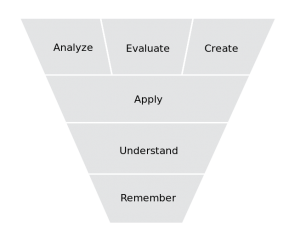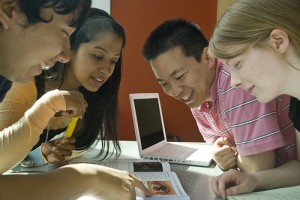 “You wouldn’t have believed me. You had to learn it for yourself!” So says Glinda the Good Witch, at the end of the Wizard of Oz (belated spoiler alert for anyone who never had a childhood).
“You wouldn’t have believed me. You had to learn it for yourself!” So says Glinda the Good Witch, at the end of the Wizard of Oz (belated spoiler alert for anyone who never had a childhood).
Perhaps in 1939, when the Wizard of Oz first came out as a film, experience as a learning tool was a novel concept. It’s a sad truth that many teachers still struggle to use authentic experiences in the classroom. Yet I can understand why. It’s much easier to teach a class on fractions than it is to help 30 student bake cookies to experience the concept. And it’s easier to teach angles without supervising a classroom of 30 amateur architects. Luckily, there are two tools that create authentic experiences without requiring high-stress lesson plans.
Bloom’s Taxonomy
In 1956, only 17 years after The Wizard of Oz made it to the big screen, Benjamin Bloom led a committee of educators to propose a new theory. The theory, now commonly known as Bloom’s Taxonomy, is laid out as a visual hierarchy, dividing learning into 6 different categories.
 At the lowest level is Memorization, or the abiliy to merely parrot back a concept. If a student learns that the question “Which fraction represents 50%?” should be answered with “1/2,” then the student is unlikely to remember the information longterm, and even if the information stays, the student will be unlikely to be able to use the information well.
At the lowest level is Memorization, or the abiliy to merely parrot back a concept. If a student learns that the question “Which fraction represents 50%?” should be answered with “1/2,” then the student is unlikely to remember the information longterm, and even if the information stays, the student will be unlikely to be able to use the information well.
Personally, I will never forget that DNA stands for “Deoxyribonucleic acid.” I repeated that with my 10th grade class every morning for 180 days. But the memorization alone did not help me – I’m sad to say, to this day I have no idea why it’s Deoxyribonucleic acid, or what acid has to do with genetic code.
The next level, Comprehension, is the ability to understand basic facts relating to the concept. In the fractions example, a student would be able to see a number divided in half, and recognize that this is both 50% and 1/2.
Beyond that comes Application. Similarly to comprehension, application requires an understanding of the basic related facts. However, application assumes that the concepts are now understood to a degree that the student could see half of a pie, or half of a group, or a silver dollar, and note the connections between them, applying the basic concept of “1/2” to unrelated situations.
At the top of Bloom’s taxonomy are three more levels of learning: Analysis, Synthesis, and Evaluation. These are the areas where authentic tasks come into play. An architect uses a variety of math skills by evaluating which one is appropriate to a situation, and then using the understanding to analyze the information. A musician synthesizes a variety of basic techniques to create something new, evaluating which technique will best serve the new piece. And so on and so forth.
The First Tool: Teaching to Learn
 Few classrooms have musical instruments, architectural firms, and baking supplies at the ready. But every classroom has a large number of students, and students can teach one another.
Few classrooms have musical instruments, architectural firms, and baking supplies at the ready. But every classroom has a large number of students, and students can teach one another.
Teaching, as it turns out, is one of the most effective authentic tasks students can participate in. By teaching concepts to one another, students pick up on the gaps in their own knowledge. Creating lesson plans and answering questions while teaching their peers allows students to dig much deeper into material than they ever would when simply memorizing or answering questions on the same material.
Who knew? Teaching is a tool every teacher has at his or her fingertips. It serves as both a way for students to learn information, and further as a way to evaluate how much of the information they have understood.
The Second Tool: Playing and Creating
Along the same lines as the benefit of teaching to learn comes the benefit of creating to learn. Specifically, creating games. When students play games, they are often challenged (if the games are well done) and learn from the experience. Many times, students are able to use skills such as our hypothetical fractions to succeed in the games, thereby helping them reach the higher levels of Bloom’s Taxonomy.
But wheras a student might win a game by mere luck, when the student is responsible for building the game, he must understand the content. If the student doesn’t know the answers, she cannot create a game that provides them.
Does every classroom have access to computers? No. But not all games are computer generated. And every classroom has access to students, with minds, who enjoy games.
Have you had students teach one another in your classroom, or create games using their knowledge? What was your experience?

Leave a Reply